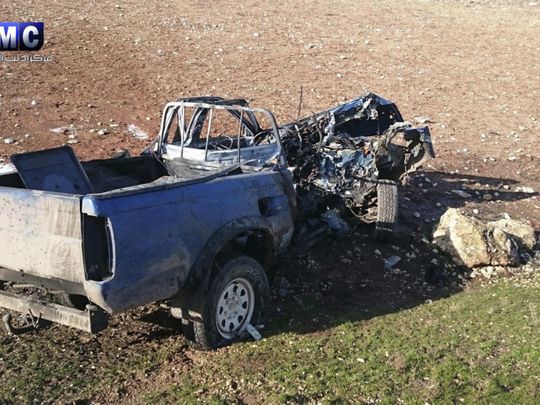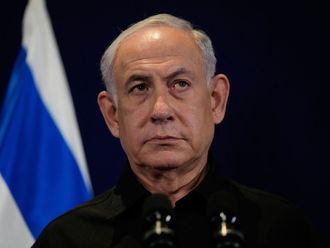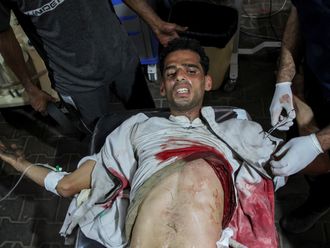
Beirut: The convoy of vehicles was driving on a dirt road in northwestern Syria when the aerial attack by the US-led coalition struck, turning the vehicles into balls of fire and the people inside into unrecognisable charred corpses.
Among the eight dead was Khattab Al Qahtani, a senior Al Qaida official with reported ties to Osama Bin Laden, as well as a Syrian Al Qaida commander from the country’s east and a militant belonging to the Turkistan Islamic Party, a faction of Chinese Islamist militants fighting in Syria.
The New Year’s Day attack was the first in a wave of air strikes that has targeted Al Qaida’s affiliate in Syria at an unprecedented rate, killing more than 50 militants allied with the international terror group since the beginning of the year.
In the throes of a brutal civil war now in its sixth year, Syria has one of the largest and most active concentrations of Al Qaida fighters in the world. The US-led coalition has been targeting the extremist group for years, hunting some of its most senior officials, including members of the so-called Khorasan group, which Washington describes as an internal branch of Al Qaida that plans attacks against Western interests.
It’s not clear what is behind the recent surge in targeted killings.
Analysts say that since Al Qaida began recruiting hundreds of fighters in Syria to expand its role in the country’s civil war against President Bashar Al Assad’s forces, agents might have infiltrated the group, which has also become more visible, setting up command centres and other outposts around northern Syria, making it easier to target.
“Had it not been for their agents they wouldn’t have been able to do anything,” a local Al Qaida commander told The Associated Press via text message from northern Syria. “They spray a product on top of the vehicle that cannot be seen with the naked eye but can be detected by the drone,” he said, speaking on condition of anonymity in line with the group’s regulations.
The stepped-up attacks could also be linked to a ceasefire brokered by Russia and Turkey that went into effect on December 30, and excludes Daesh and Syria’s Al Qaida affiliate, known as the Fatah Al Sham Front. Turkey and Russia back rival sides in the Syrian conflict and their new push to try to end the war includes talks between the Syrian government and the opposition to be held later this month in Kazakhstan.
The intensified attacks also come at a time when Daesh, an Al Qaida rival, is under intense pressure and losing territory in Iraq and Syria. Iraqi forces are on the offensive in the northern city of Mosul, the main IS stronghold in Iraq, while US-backed Kurdish-led fighters are marching toward the Syrian city of Raqqa, Daesh’s de facto capital.
“Daesh is on the verge of collapse and this is diverting the attention toward Al Qaida,” said Dana Jalal, a Sweden-based expert on Islamist militancy. “The new Russian-Turkish alliance is also leading to fresh intelligence information.”
Jalal said Turkey is now sharing intelligence about the Al Qaida affiliate with Russia, as well as the US-led coalition. Turkey has been a main point for foreign fighters to cross into Syria and borders the country’s northern Idlib province, where thousands of Fatah Al Sham fighters are based.
Reflecting the intensity of the attacks, the group distributed a list this week of suggested ways for its fighters to avoid being targeted by air strikes, urging total “electronic silence,” the use of camouflage and devices that disrupt the frequency used to control drones and only using buildings “with multiple exits.”
The Fatah Al Sham statement was carried by the SITE Intelligence Group, a US group that monitors militant internet traffic.
The rise in attacks on Al Qaida fits in with the US government’s contention that it is gaining traction against a range of militant groups, including Fatah Al Sham and Daesh in Syria and Iraq. The US has also stepped up attacks against Daesh militants in both countries, including a high-profile operation on Sunday that targeted a Daesh force in the eastern Syrian province of Deir Al Zor.
In that attack, commandos flown in aboard four helicopters intercepted a vehicle carrying several Daesh militants, killing all of them and flying off with the bodies, Syrian opposition activists said. US Navy Captain Jeff Davis confirmed that a raid took place on Sunday but did not provide details.
There was no comment by the Pentagon on the surge in attacks this year, but the US has announced numerous successful strikes in recent months.
Charles Lister, a senior fellow at the Washington-based Middle East Institute, wrote in a Facebook post that Fatah Al Sham’s decision to operate more openly makes it vulnerable to air attacks and external infiltration. Since July 2015, US aircraft have killed some of Al Qaida’s most senior figures in strikes in northern Syria, including Kuwait-born Mohsen Al Fadli, Sanafi Al Nasr of Saudi Arabia and Ahmed Salama Mabrouk of Egypt, who was killed in October. Rifai Ahmad Taha, an Egyptian militant with decades of experience with the terror network, was killed in a US strike in April.
This month’s attacks come as Fatah Al Sham has been trying to improve its image and distance itself from Al Qaida. In July, its leader, Abu Mohammed Al Golani, publicly showed his face for the first time in a video in which he announced the group was changing its name and cutting ties with the international terror organisation. Sitting next to him was Mabrouk, who was killed in a US air strike three months later.
Three days after the January 1 air strike that killed eight militants, warplanes of the US-led coalition struck one of Fatah Al Sham’s largest centres in the town of Sarmada, killing 25 people, including seven militants. A day later, the US said five militants were killed in one strike and more than 15 in another.
On January 6 Fatah Al Sham announced a leading member, Younis Shoueib, also known as Abul Hassan Taftanaz, was killed along with his son in an air strike in the country’s north. He was reportedly close to Al Golani, the Fatah Al Sham leader.
On Wednesday, air strikes in the northwestern town of Saraqib killed at least 10 suspected Fatah Al Sham militants. The strikes reportedly destroyed two vehicles and three motorcycles.
Ali Al Omar, the head of Ahrar Al Sham, a rebel faction in Syria that has maintained good ties with Fatah Al Sham, said in an interview aired on Thursday that the escalation in strikes targeting the Al Qaida-linked group’s leaders was helping Al Assad by excluding other militant groups fighting alongside the government, such as the Lebanese militant Hezbollah group.
“Targeting a faction that is confronting the regime and whose members are mostly Syrians is biased and is a position against the revolution and in support of the regime,” he said.












